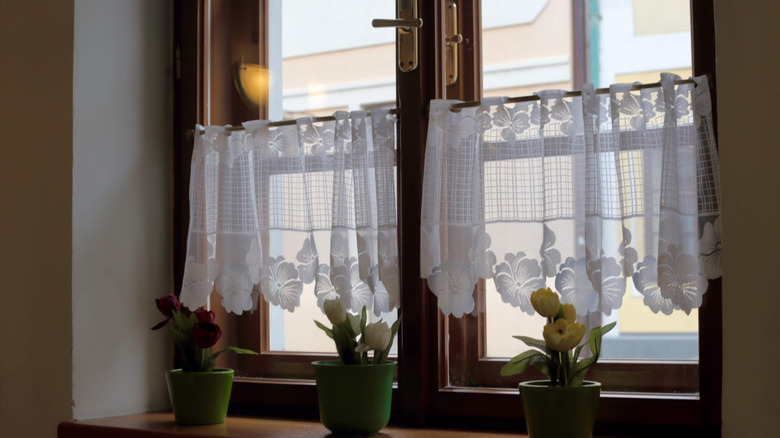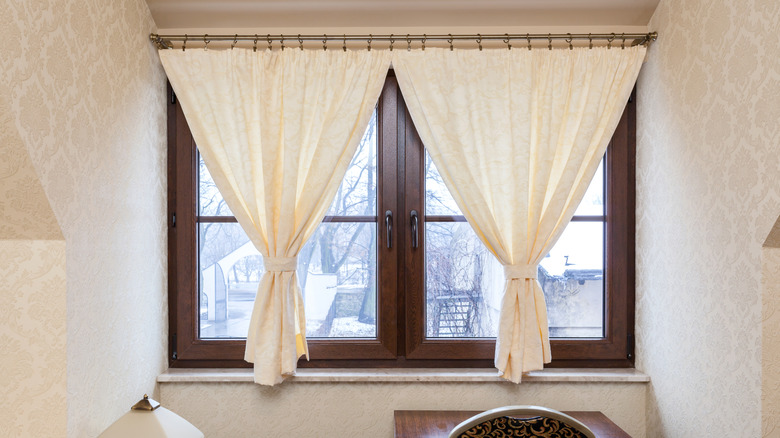The Best Types Of Curtains To Hang On Tension Rods
Tension rods are a savvy solution to add cozy and practical curtains to a room without needing to find your tools. Instead of being attached to the wall, tension rods use springs to push against two walls and stay in place. These rods allow you to hang curtains without damaging walls, which is especially beneficial in rentals, but the impermanence means you need to be a bit pickier about what types of curtains you hang so that your curtain rod does not fall. The main thing to consider when looking for curtains to hang on a tension rod is the weight of the curtains. Fabrics that are too heavy for your tension rod will cause an unflattering dip in the rod or a collapse. The best curtains for a tension rod are made of lightweight fabrics, but you can use almost any curtain cut.
Before you figure out which type of curtains will be the best, you need to take a look at your tension rod. Tension rods spanning wider spaces are more likely to dip in the middle without any central support, and these rods will also need the lightest possible curtains to prevent a more dramatic sag. The diameter of the rod is another important factor to consider. Rods with larger diameters will be able to support more weight. If you know which tension rod you have, many brands will list the weight capacity of the rod so you can choose the correct curtains.
The best curtain fabrics and styles for tension rods
Lightweight fabric options include silk, voile, cotton, linen, polyester blends, and more. You can find many sustainable curtain fabrics that work for tension rods. Just remember to compare the weight limit of the rod with the weight of the curtains, as mentioned. Typically, lightweight fabrics are somewhat sheer, which gives a room a lovely open, airy feeling, but it is not always the style you want. In bedrooms, for example, you may want to block more light from entering the room. Fabric for blackout curtains is typically polyester, a heavier material. A polyester blend may be a bit lighter, but you might still need a heavy-duty tension rod that can bear more weight.
As for styles, you have many options. Any color will do, and you can make most shapes and sizes work as well. Cafe and apron curtains are great choices because they offer privacy and coziness with a weight that is a fraction of a full-length curtain. With a shorter curtain, you can get away with a slightly weightier fabric. You can also do floor-length curtains, but you may want to avoid puddle curtains. One wrong step can bring your curtain rod down, so extra fabric pooled on the floor is a recipe for disaster. Plus, extra fabric means additional pressure on your tension rod, which, if it does not cause a fall, can cause the dreaded and unsightly sag.
Tips for choosing curtains
If you are having trouble choosing a fabric or style, there are some tips to choose the perfect curtains for your space. Measuring your windows and the length between the window and the floor can give you a better understanding of your ideal curtain size. Thinking about the function of curtains can also help you find what you want. Figure out if you want curtains for privacy, darkness, or just style. Most curtains will add a bit of privacy, but darker colors and more opaque fabrics will provide more privacy. Blackout curtains or liners will help block light, but it will be tough to find ones light enough to keep your tension rod from bending. If you are mostly looking to add the finishing touches to a beautiful room, focus on colors and patterns that match.
Overall, the best type of curtains for a tension rod are the ones that are light enough not to cause problems for the curtain rod. So, choose between a thick or thin curtain rod, then determine how much weight it can hold. Hardware also matters. You can choose curtains with grommets or a no-hardware setup that spares some weight. For fabric, options like cotton, linen, and polyester blends should be light enough, and you can check the packaging to verify the weight.


